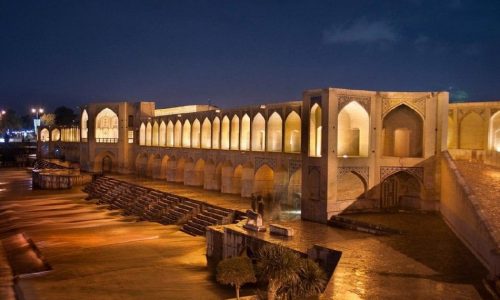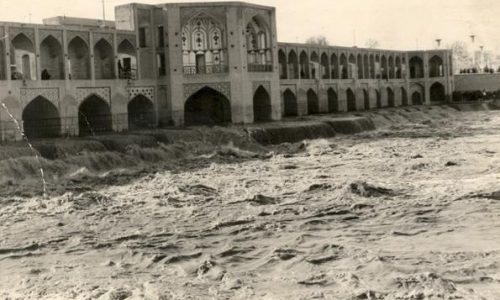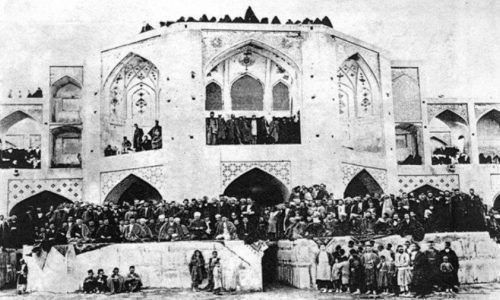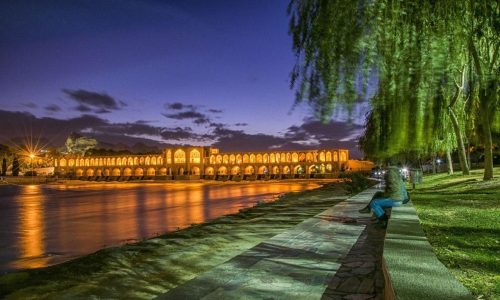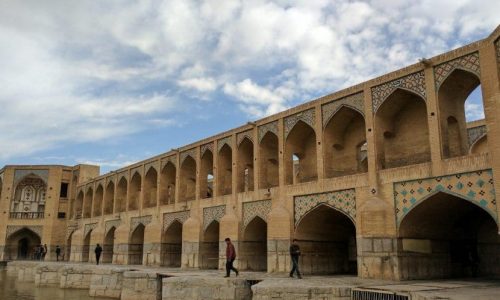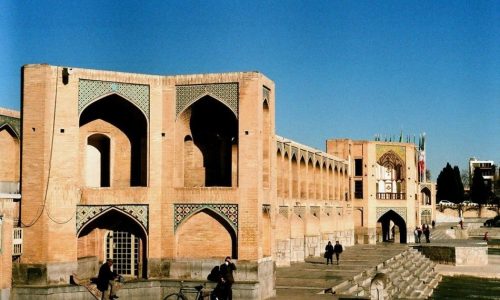Khaju Bridge is one of several bridges on the Zayandeh Rood River, which is known as the most beautiful bridge in Isfahan. This bridge is located in the east of 33 bridges and in addition to eye-catching architecture, it also displays beautiful paintings and its middle part shines like a jewel. Khaju Bridge was built by the order of Shah Abbas II Safavid and became famous as one of the most beautiful bridges in the world in its time due to its architectural features and the use of tiled decorations.
Due to the value of this historical monument, its name has been included in the list of national monuments of Iran since January 6, 2013 with the number 111.
History of Khaju Bridge
What is known today as Khaju Bridge was built in 1060 AH by order of Shah Abbas II and on the ruins of a bridge left from the Timurid period called Hassan Beyk Bridge. According to historical writings, the base of this bridge existed before the Islamic government, was repaired during the Turkmen period and reached its peak of glory during the Safavid period.
Construction of a bridge during the reign of Shah Abbas
Historical writings state that because this part of the Zayandeh River is deeper than other parts of it, Shah Abbas chose this place to build a bridge. This bridge prevented the Zoroastrians, whose neighborhood was on the other side of the river, from crossing Chaharbagh Street to cross the Zayandeh River and taking a shorter route. But according to some historians, in the current location of Khaju Bridge, there was an unused and ruined bridge that Shah Abbas II ordered according to a special plan, a bridge should be built on this bridge, which is located near Saadatabad Garden and Ayneh Khaneh mansion. have been. The staff was obliged to make this bridge more beautiful than other bridges in Zayandehrud and to build the best of them.
But according to some historians, in the current location of Khaju Bridge, there was an unused and ruined bridge that Shah Abbas II ordered according to a special plan, a bridge should be built on this bridge, which is located near Saadatabad Garden and Ayneh Khaneh mansion. have been. The staff was obliged to make this bridge more beautiful than other bridges in Zayandehrud and to build the best of them.
Khaju Bridge in the Qajar period
During the reign of Biglar Beigi Sadr Isfahani – the third prime minister of Fath Ali Shah between 1234 and 1239 AH – an upstairs was built on the bridge in his name, which in 1310 AH Zol-e-Sultan – son of Nasser al-Din Shah – ordered its destruction. According to the Kufi inscription, which is located on the south right side of the bridge, Khaju Bridge was restored in 1290 AH at the same time as the reign of Nasser al-Din Shah Qajar by a politician named Nasrullah Khan.
In the year (1060 AH) when the bridge was built and became known as the royal bridge, after the Nowruz holiday of that year, according to the order of second Shah Abbas, the bridge was decorated and illuminated and each of its pavilions was decorated by one of the commanders and The elders and prepared it for the celebration, and the poets of Mashhad composed poems in 45 verses, and Saeb Tabrizi composed poems describing that illumination and celebration.
Khaju Bridge Architecture
One of the remarkable points in Khaju Bridge is the amazing architecture of this structure, which we will discuss its features in the following:
The length of Khaju bridge and the number of its spans
There is disagreement about the length of the bridge and the number of spans. For example, Tavernier, a European tourist, says about these characteristics:
This bridge, which is 150 meters long, 14 meters wide and 7.5 meters wide, is made of stone and brick and has 21 atmospheres and 26 spans.
But what can be seen in today’s books is 132.5 meters long and 12 meters wide, and of course the number of spans of this bridge has been written by some as 26, some as 24, some as 21 and others as 28. Accordingly, it is possible that the bridge has undergone changes throughout history and some parts of it have been destroyed.
The key to the strength and stability of the bridge over the centuries
Bridge foundation
In terms of foundation, the foundations of Khaju Bridge are located on a rock consisting of round and coarse-grained pieces called conglomerates, which form a resistant layer. During construction, layers of river sand were removed at the bridge site and the foundation of the bridge was built on a layer of conglomerate. The riverbed is paved next to the bridge piers to minimize the destructive effects of water such as erosion and waterlogging.
Accurate calculations
Examining the large, precise and heavy foundations of Khaju Bridge, we find that the dimensions of the bridge are well calculated in all directions and despite its high weight, it has resisted water pressure for years. The pressure of water movement in the river and the pressure of water stagnation near the bridge piers can endanger the life of this effect.
Materials used in construction
The bases under the piers are made of heavy and large stones and their shape looks like water breakers and stepped water breakers
Water breaker and stairs
The pointed shape of the foundations above the bridge is like a water breaker that minimizes the pressure from the river to the bridge. The stepped shape of the foundations of downstream also allows water to flow over the foundations in the event of a flood or the closure of waterways to use the bridge as a dam. Water loses its energy in dealing with them by crossing the stairs so that when it reaches the riverbed, it does not have destructive and erosive energy.
Song arches and sweaty domes
The arch on the foundations or the roof on which the bridge passage is located consists of a system of song arches and sweat domes. The use of this form in the structure of the bridge creates excellent load-bearing and stability, which must have been considered by the architect for repeated use over the centuries.
The principle of symmetry in the architecture of Khaju Bridge
All works of art, science, religion, philosophy, and engineering in the history of Iran express the beliefs of Iranians in symmetrical and orderly phenomena and structures. The design of Khaju Bridge is also a kind of reflective symmetry or mirror that has its own beauty.
The principle of proportionality in Khaju bridge
The principle of proportionality in architecture is an issue that creates a sense of order between the components of a composition visually. Khaju Bridge has also benefited from this and has a linear spatial organization that consists of repeating spaces of the same size and shape with the same function.
Under the bridge, there are 21 halls that are spaced apart and connected by a middle space.
Cost and time table to visit Khaju Bridge
Ticket price: free
Opening hours: 24 hours a day
English and Farsi address of Khaju Bridge
Khaju Bridge, Kamal Esmaeel street, Isfahan
اصفهان، خیابان کمال اسماعیل، پل خواجو






